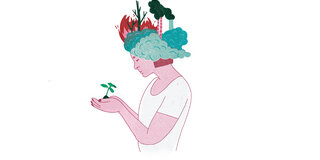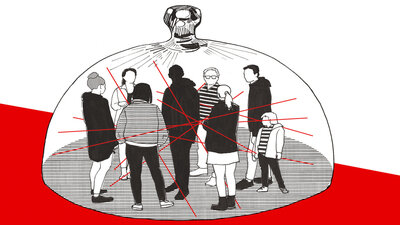Let’s Do It - How To Protect Our Climate

There is a lot that needs to be done in order to save the climate - and a lot that each one of us can do.
© W&B/Sylwia Kubus
Nutrition – Less animal-based food, more plant-based: Why that is good for our climate.
Energy – How to save electricity and gas – and a lot of money, too.
Consumption – How did all that stuff get into my wardrobe? Do we really need it all?
Mobility – We don’t always need the car. Let’s use the bike, the train and the bus more often!
Nutrition: What Would You Like?
Eating for the climate. Every day, we take numerous decisions linked to our diet. What can we do to keep climate and environment in mind?
Butter or Margarine?
If you simply look at the carbon dioxide balance, things are pretty obvious: ‘Butter loses out to margarine’, says Dr Guido Reinhardt of the Institute for Energy and Environmental Research (ifeu) in Heidelberg. The scientist researches the sustainability of foodstuff. Because of the high fat content in butter, you need a lot of milk to produce butter. A lot of milk means – put simply – a lot of cows, who release a lot of methane into the atmosphere by belching and farting – a greenhouse gas about 25 times as harmful as carbon dioxide. ‘Dairy products are responsible for up to a third of the environmental pollution caused by nutrition’, Reinhardt adds. Therefore, it is advisable to use butter and other fatty dairy products sparsely. If you go for margarine instead, make sure it contains no palm oil. While oil palms are high-yield, their cultivation causes the clearing of good carbon dioxide reservoirs like rain forests and bogs.
Glass Bottle or Tetra Pak®?
There is no obvious answer. Packing has a big influence on the climate balance when it comes to pulse, vegetables – and beverages. First advice: Switch from mineral to tap water. That will help you save money, energy and packaging. A number of factors determine how climate-friendly a packing is. It is always an advantage if it does not weigh too much and can be used repeatedly without long-distance transport. ‘Disposable glass and tins often have an impact five to ten times as strong as the content’, Reinhardt explains. Glass is heavy and uses up a lot more energy in production than a PET bottle, but it can then be used more often. With reusable bottles, we should look out for pool bottles used by many bottlers. You can identify them by their embossing and the wearout from multiple usage. For milk, don’t go for reusable bottles, as they are often transported over some distance: We have very few multi-way dairies.
Regional or Organic?
Organic farming has many advantages: It does not harm soils and groundwater as much as conventional farming. The fields release less nitrous oxide (laughing gas), which is about 300 times as detrimental to the climate as carbon dioxide. In organic livestock farming, less antibiotics are used and the animal welfare standards are higher. On the other hand, it makes sense to buy apples from Brandenburg when in Berlin, not from New Zealand. However, foodstuff is not automatically climate-friendly just because it was produced nearby. Tomatoes grown regionally in heated hothouses still have a bad climate balance. Reinhardt advises: ‘Combine regional and seasonal.’ That combination works for the climate. Unfortunately, fruit and vegetables get thrown away particularly often and thus contribute to food waste. A good weekly menu can rectify that – and the appropriate storage.
Chips or Boiled Potatoes?
Processing can ruin the climate balance of foodstuff. A kilogramme of frozen chips causes about four times as much carbon dioxide as a kilogramme of unprocessed potatoes. Generally, we do not have enough data regarding the climate balance of processes food consisting of various ingredients. However, one thing we do know: A high proportion of vegetal ingredients reduces the impact upon the climate, according to a research team at the University of Oxford. They analysed about 57,000 different foods.
Fish or Meat?
Consume both rarely and consciously. If you do, go for organic produce. Our meat consumption is the most important adjusting screw for a climate-friendly diet. Beef produces by far the most climate gas, poultry far less. If you eat fish, watch out for species, place of origin, method of capture or breeding technique. The WWF Seafood Guide is good advice – and available as an app.
No Meat, No Fish: If all readers of the Apotheken Umschau were to become vegetarians for a year, there would be the following reduction in carbon dioxide: 0.44 tons per person; 7.8 million tons for the estimated 17.81 readers of the Apotheken Umschau.
Energy - Where Can You Make Saves?
Household. In your own flat or house, too, you can reduce the emission of climate gases like carbon dioxide. And that also reduces your payments for electricity and gas.
Opt for Green Electricity
On average, the production of a kilowatt hour of electricity causes the emission of 485 grams of carbon dioxide, according to the current electricity mix in Germany. Real green electricity reduces the carbon dioxide output by at least 90 per cent. If you can afford it, you should opt for a product with the label ‘ok power’ or ‘green electricity’. It certifies suppliers who invest into the expansion of renewable energies. Other suppliers often simply buy certificates of conformity for carbon dioxide emission, subsequently calling their electricity ‘green’.
Use Your Household Appliances Cleverly
Washing machine: Wash at low temperature. 60 degrees centigrade are generally only needed for underwear, socks and bedclothes.
Fridge: Set temperature to seven degrees centigrade, not four degrees. When buying a new model, forgo an integrated freezer compartment if possible.
Dishwasher: Set the dishwasher to 50 degrees centigrade, not 60 degrees. Only start the machine when it is full.
Freezer: Only open the door for a short time span. Defrost the appliance when frozen over.
Cooker and oven: Do not pre-heat the oven. Use air circulation instead of top or bottom heat. Always try and put the lid onto the pot if possible. Heat water in the electric kettle.
Reduce Warm Water
Water-saving showerheads can reduce the passage of water by half without minimising the pleasant feeling under the shower. An instantaneous water heater running on electricity is also helpful: After buying one, a family of three saves 1463 kilowatt hours of electricity per annum, equalling 710 kilogrammes of carbon dioxide – according to Stiftung Warentest. Further saving measures: Only shower for six minutes. Turn the water off while lathering. Wash your hands with cold water. Those measures save 300 to 600 kilogrammes of carbon dioxide per year.
Choose Economical Appliances
Choose energy-efficient appliances when buying new ones. Since March 2021, there is a European-wide labelling from A to G for washing machines, fridges and freezers, televisions sets and monitors. A QR code supplies the customers with additional information like electricity consumption.
Reduce Your Heating Bill
If you lower your room temperature by just one degree centigrade, you save about five to six per cent of energy. 20 degrees centigrade should be sufficient in the living area, 17 degrees in the bedrooms and unused rooms.
Switch the Bulbs
LED lamps use up only a fifth of the energy used up by traditional light bulbs or halogen bulbs. And they last much longer. LEDs are available in all the usual bulb sizes and types. If you switch from conventional lighting to LED technology, you save over 80 per cent of the energy for light.
Clothes Line Instead Of Tumble Dryer
If you forgo the tumble dryer in favour of the clothes line, you avoid the release of 110 kilogrammes of carbon dioxide per annum. If all of the estimated 17.81 readers of the Apotheken Umschau who own a tumble dryer were to do that, 374 million kilogrammes of carbon dioxide would not be released into the atmosphere.
Consumption - Buy Just Half Of It
Less is more. To think consumption anew and to reduce does not merely help our climate. It also generates happiness. Try it out!
Do I Really Need That?
‘When we go shopping, we often satisfy some needs’, says Dresden-based communication psychologist Anita Habel, an activist with Psychologists For Future. Unhappy in your job? Searching for recognition? Shopping can make you feel better. The problem: Your feeling of happiness does not last very long. Clothes, technical gadgets, deco – ‘Make yourself realise what you’ve already got’, Habel advises. That can be an eye-opener. There might be more things than you actually use. ‘They were bought to fulfil needs, not because you needed them.’ On average, every wardrobe contains twelve unworn pieces of clothing. So ask yourself when shopping: Do I really need this? If there is no assured yes, the answer is no. Habel opines: ‘If I begin to ponder, that is a sign that I do not need it.’
Avoid Impulse Buys
Limited edition, special offer, now new! These advertising messages lead us into buying things we do not need. Advice: Set yourself a waiting period. Ask for the piece to be retained in the shop, or leave it in your online shopping basket. Wait for three days. ‘Quite often, we notice then that we do not really need the new acquisition’, Habel says.
Choose Durable Goods
If you use products for a long time, you protect the climate. Examine the quality before your purchase, for example with clothing. Is the fabric densely woven? Can you see lose threads? Are the seams well-stitched? Are the buttons solidly fixed? Does the zipper work? When buying technical gadgets, ask if the product can be repaired and how much you would be charged.
Question Sustainability Promises
Advertising messages like ‘organic’ promise shopping with a good conscience. But often enough, they are not true. With textiles, the term is often not protected – unlike with foodstuff. Companies invent their own labels, promising sustainability. At second view, they are often eyewash. Advice: Watch out for externally-certified labels. Here’s an overview: www.siegelklarheit.de
Enjoy Your Success
The problem with buying less: ‘When we don’t do something, we don’t see success. The reward effect fails to materialise – that can be demotivating’, Habel explains. Her advice: Reward yourself and make your success visible: ‘Collect the money you saved in a penny bank, for an outing with your family or a nice dinner.’ That way, you reward yourself twice, Habel explains: ‘Nice experiences make us happier in the long run than buying things.’
Sharing, Swapping, Lending, Borrowing
How often do you really need your electric drill? The carnival costume? How often do you re-read a novel? We use many things rather sparingly. It therefore makes sense to go for sharing, swapping, borrowing and lending. That protects the climate – and your bank balance. Check out online platforms, neighbourhood initiatives and, of course, public lending libraries. And if you really want to own something, go for second-hand, buy it on online platforms or at flea markets.
Minus Fifty Per Cent
Every German, on average, produces the emission of 3.4 tons of carbon dioxide per year through shopping. Half of the consumption would effectively cancel out 1.7 tons per head. That would equate accumulated savings of 30.3 million tons of carbon dioxide for the estimated 17.81 readers of the Apotheken Umschau.
Mobility - The Traffic And Transport Turnaround
Arriving Sustainably. Mobility is responsible for 20 per cent of our carbon dioxide emission. That is too much. But there is potential for savings. Here are six suggestions.
I’m Walking, Yes Indeed …
The greenhouse gas emission in the German traffic sector should be lowered from 148 million tons today to 85 million tons in 2030, according to the Federal Climate Change Act. But how to go about that? The Federal Environment Agency recommends political measures: speed restrictions, getting rid of subventions for company cars and kerosine, propping up rail travel. But everyone can – no, must! – reduce his or her personal carbon dioxide footprint. If you walk (or cycle), you move from A to B completely emission-free. The Federal Bureau of Statistics reckons that a complete abandonment of car, public transport and train would reduce the current average individual annual wastage of 10.78 tons of carbon dioxide by 15 per cent.
Ø Potential savings: 1.6 tons of carbon dioxide per year.
Switching to Public Transport
Even if employees travel less these days due to the increase in home-office work – not everybody can walk to the workplace. But there are more environment-friendly options but the car: Experts reckon that a petrol-driven car of average age generates 945 kilogrammes of carbon dioxide per year on a 20 kilometres to and 20 kilometres fro commute every working day. With bus or train, it is about a third. The recent success of the 9 Euro ticket has shown that many Germans are willing to switch to public transport.
Ø Potential savings: 626 kilogrammes of carbon dioxide per year.
Train Instead of Inland Flight
Aeroplanes have the worst reputation of all means of transport. And rightly so. On top of an abysmal carbon dioxide emission balance, they add nitrogen and water vapour into the higher atmospheric layers. Especially when travelling inside Germany, the alternative is a train journey. The time disadvantage of the train compared to air travel (and all the time lost at the airports) is relatively low, the climate advantage, however, is huge.
Ø Potential savings: 1.8 tons of carbon dioxide per year.
Car Sharing
A private motor vehicle is moved around for just one hour a day on average. For the other 23 hours of the day, it blocks valuable square footage, especially in the cities. Car sharing is not only financially advisable: It also helps to protect the environment. Less cars used more frequently definitely have a better environmental balance than more cars used less frequently – just think about the production cost in terms of carbon dioxide emission. Also, according to the Federal Environment Agency, car sharing customers drive less than owners, as they scrutinise the necessity of every trip in advance.
Ø Potential savings: about 300 kilogrammes of carbon dioxide per year.
Combustion Engine? Electric Car!
The Federal Environment Agency has identified eight areas with the potential to make a difference in terms of climate-friendly transport. The biggest potential for savings is attributed to ‘efficiency and the electrification of cars and light commercial vehicles’. In other words: away from combustion engines, towards cleaner alternatives. Electric vehicles are already 20 to 30 per cent more climate-friendly over their lifespan compared to petrol- or diesel-driven cars. Dr Matthias Buchert of the Institute for Applied Ecology in Freiburg predicts: ‘Especially with the production of lithium ion batteries, the carbon dioxide footprint will get even smaller due to the economy of scale, and due to a more advantageous electricity mix.’
Ø Potential savings: 588 kilogrammes of carbon dioxide per year.
Take the Bike to the Kindergarten
Avoid using the car for short distance. Take your kids to the kindergarten on your bike, for example. Professor Gang Liu, an expert for green technology at the University of Southern Denmark in Odense emphasises the importance of short cycle trips: ‘If everybody would cycle as much as the Danes – 1.6 kilometres per day—, we would save as many tons of carbon dioxide as the whole of Great Britain emits.’
Ø Potential savings: 236 kilogrammes of carbon dioxide per year.
E-Bike Instead of Car
If all 3.14 million e-bike users amongst the Apotheken Umschau readership were each to replace 1,500 kilometres in the car with their bike, they would save a tremendous amount of carbon dioxide: 294 kilogrammes per head.






